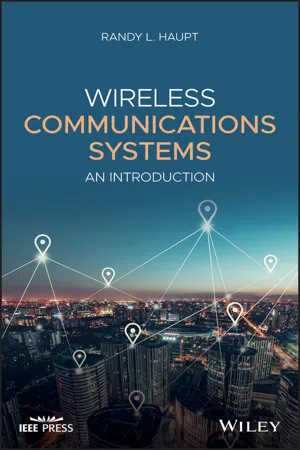
- English
- ePUB (mobile friendly)
- Available on iOS & Android
About this book
A comprehensive introduction to the fundamentals of design and applications of wireless communications
Wireless Communications Systems starts by explaining the fundamentals needed to understand, design, and deploy wireless communications systems. The author, a noted expert on the topic, explores the basic concepts of signals, modulation, antennas, and propagation with a MATLAB emphasis. The book emphasizes practical applications and concepts needed by wireless engineers.
The author introduces applications of wireless communications and includes information on satellite communications, radio frequency identification, and offers an overview with practical insights into the topic of multiple input multiple output (MIMO). The book also explains the security and health effects of wireless systems concerns on users and designers. Designed as a practical resource, the text contains a range of examples and pictures that illustrate many different aspects of wireless technology. The book relies on MATLAB for most of the computations and graphics. This important text:
- Reviews the basic information needed to understand and design wireless communications systems
- Covers topics such as MIMO systems, adaptive antennas, direction finding, wireless security, internet of things (IoT), radio frequency identification (RFID), and software defined radio (SDR)
- Provides examples with a MATLAB emphasis to aid comprehension
- Includes an online solutions manual and video lectures on selected topics
Written for students of engineering and physics and practicing engineers and scientists, Wireless Communications Systems covers the fundamentals of wireless engineering in a clear and concise manner and contains many illustrative examples.
Frequently asked questions
- Essential is ideal for learners and professionals who enjoy exploring a wide range of subjects. Access the Essential Library with 800,000+ trusted titles and best-sellers across business, personal growth, and the humanities. Includes unlimited reading time and Standard Read Aloud voice.
- Complete: Perfect for advanced learners and researchers needing full, unrestricted access. Unlock 1.4M+ books across hundreds of subjects, including academic and specialized titles. The Complete Plan also includes advanced features like Premium Read Aloud and Research Assistant.
Please note we cannot support devices running on iOS 13 and Android 7 or earlier. Learn more about using the app.
Information
1
Introduction
1.1 Historical Development of Wireless Communications

Table of contents
- Cover
- Table of Contents
- Preface
- Symbols and Acronyms
- 1 Introduction
- 2 Signals and Bits
- 3 Passband Signals
- 4 Antennas
- 5 Propagation in the Channel
- 6 Satellite Communications
- 7 RFID
- 8 Direction Finding
- 9 Adaptive Arrays
- 10 MIMO
- 11 Security
- 12 Biological Effects of RF Fields
- Appendix A: MATLAB TipsMATLAB Tips
- Appendix B: OSI LayersOSI Layers
- Appendix C: Cellular GenerationsCellular Generations
- Appendix D: BluetoothBluetooth
- Appendix E: Wi‐FiWi‐Fi
- Appendix F: Software‐Defined RadiosSoftware‐Defined Radios
- Index
- End User License Agreement